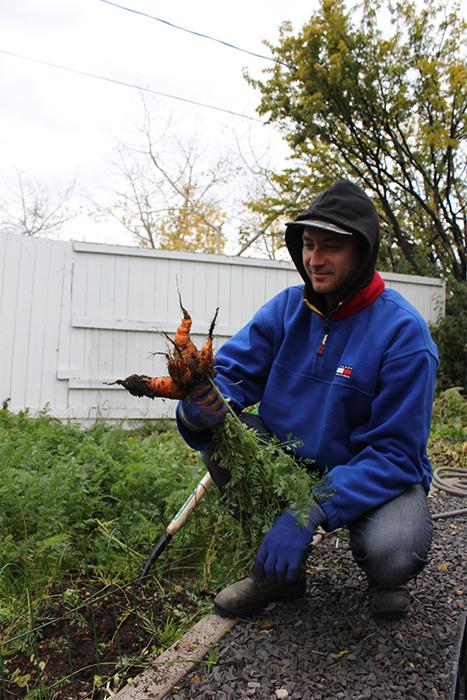Photo by Rachel Ziriada
BFA IN PRINT MEDIA, 2006
ALUMNI DISCOVERY INITIATIVE, INTERVIEW BY KERRY MAGUIRE, 2015
Instagram: @NASARIMBA_
Kerry Maguire: Have you remained in contact with ACAD much since you have graduated?
Mikhail Miller: Not too much, I was here in the springtime [2015] and participated in these roundtable discussions with alumni asking our opinions regarding some things about the school. I’ve been away from Calgary for a while and have just recently moved back, so I’m not completely in the loop with what’s going on at ACAD.
Maguire: When did you graduate?
Miller: In 2006. I went straight from high school to ACAD. It was fun, I think there’s maybe pros and cons when students go straight to art school out of high school. Maybe later on (in my 20s) would have been a more optimal time for me to go, because you have a few more things sorted out.
Maguire: What was your major?
Miller: Printmaking. I wanted to learn some technical skills. It was cool, but I ended up not really making a lot of prints, though I still make prints in some regards. My printmaking background definitely influences what I do. When I was in third and fourth year, my work was more loosely connected to printmaking. The critiques in that department were more technical and processed-based; in hindsight, by the end of my degree, I probably belonged somewhere more conceptual.
Maguire: ACAD actually offers a print minor now.
Miller: That’s really cool, that would have been ideal for me. I went to England in my third year for the exchange program, and that’s something which I definitely recommend. It was interesting to see their school’s structure. It was really loose. You have tutors, they’re not really teachers per se. You check in with them every week or two in a meeting, but it’s mostly self-directed practice. It was both good and bad for me at the time.
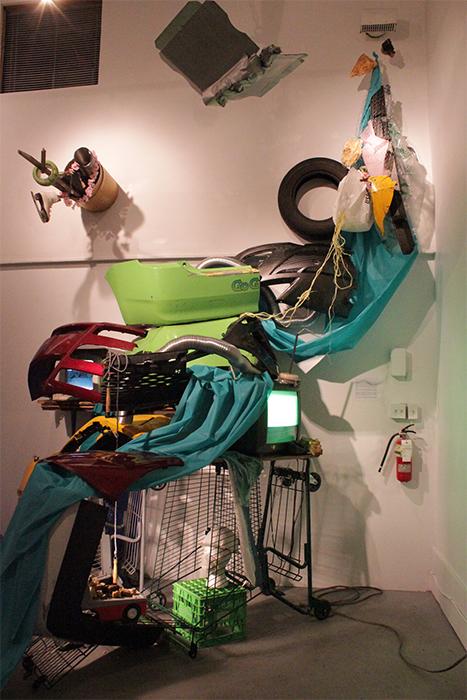
Photo by Rachel Ziriada. Processing Rock Bay 2015 Mixed Media Installation by Mikhail Miller and Rachel Ziriada at the Fifty Fifty Arts Collective in Victoria, BC.
Maguire: Did you have critiques with other students?
Miller: There were a few opportunities to do that. I guess I kind of got lost in the system, just being there for one semester. I was kind of forgotten about, but it was actually a nice change from the really regimented five classes a week at ACAD. Though there is something to say for the structured way ACAD’s classes are set up, it was nice to have the fluidity in England. There wasn’t really majors or minors or anything which I thought was cool because when you’re an artist you use such a huge range of skills and techniques.
Maguire: That definitely reflects the Processing Rockbay installation you recently did in Victoria. It incorporates almost everything: video, drawing, sculpture…
Miller: Especially with contemporary practice, which I am kind of re-learning, you need to be versed in multiple different media. I always thought ACAD was awesome because it’s very unique to be working right alongside jewellers, fibre majors and design students. My partner just graduated from the University of Victoria which is a totally different kind of art school. There’s a vibrancy at ACAD that not many other places have.
Maguire: How has your artistic practice evolved since you left ACAD? I know that a lot of your work involves social consciousness – is that something you learned at ACAD or something you picked up along the way?
Miller: I came to ACAD with some personal ideas and social perspectives and made that work for me within my education. After ACAD I moved to Vancouver briefly. I applied for a residency at the Banff Centre, and they ended up having a spot for me. I applied for a grant which didn’t go through, but I decided to pay for it and do it anyway. It was a really interesting time.
During my residency, the facilitators at The Banff Centre told me about an opening for a printmaking work study opportunity at the Centre, so I applied for that. It was for a whole year. It was a really cool experience, and made it financially worth my while after doing the residency. I got to meet a lot of amazing people that were making great work. And although it was great, there was also a part of me that at that time was turned off by that kind of art world and institution. I was coming from a background of activism. I had a craving to prove to myself that I could do and make work outside of that tradition.
So, for better or for worse, working outside of those institutions was the trajectory I followed after The Banff Centre. The Banff Centre was an over-saturation, I was always prompted to be thinking about curators, grants, and residencies… it was great, though. I was helping facilitate all these masters’ students and practicing artists. But for myself, I felt a little disconnected. It would have almost been better not to have come from Calgary, because I had so many connections in Calgary and would go back almost every weekend. And Banff, as a town, is a little strange.
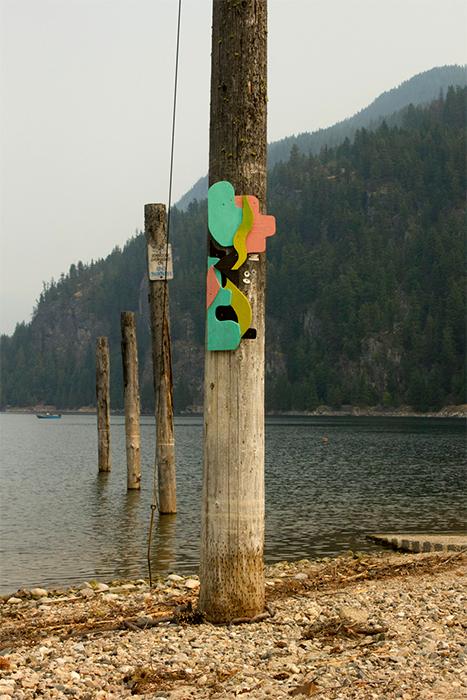
Photo by Rachel Ziriada. Untitled 2017 Pole Installation by NASARIMBA (Mikhail Miller + Rachel Ziriada) in Slocan, BC.
Maguire: I’ve heard that it’s an odd place to live.
Miller: Yeah, it’s almost a non-place. There’s so many tourists. There’s definitely a great community at The Banff Centre, though.
Maguire: The location is very different from ACAD, which is much more integrated into the city. Lots of the teachers, students and staff are very present in the larger art community.
Miller: When I moved to Victoria after being in Banff, I got involved with an artist-run space there called the Ministry of Casual Living. It was a crash-course in curatorial practice, and kind of a residency. I was living in the space, which had a front area with a moveable wall and a window on the street level. We were doing a show every week in the front space, and I was living in the back space.
Maguire: How long did you do that for?
Miller: Eight months.
Maguire: Wow, so a different show every week for eight months?
Miller: Yeah, it was really challenging. I was also paying the rent there. It was a lot of work, but it was awesome to curate and program a space. We had little music shows, different kinds of events. I got some artists from Calgary to come show their art.
Maguire: Sounds like the complete opposite of The Banff Centre.
Miller: It was different, for sure. Through The Ministry of Casual Living, I became involved with a different kind of art world, which was graffiti and street art, mural painting, stuff like that. I immersed myself in that culture for a while.
Maguire: That’s funny, it’s almost like you progressed upriver from what most people do. A more common story might start with graffiti and street art, then move on to ACAD, and then The Banff Centre.
Miller: It was a weird way to meander. For a long time, I was making work influenced by that illustrative street art culture. Now I am seeing what I can gather from both of those worlds. I’m trying to get more involved in the contemporary art community, which is what I am currently working on doing right now in Calgary.
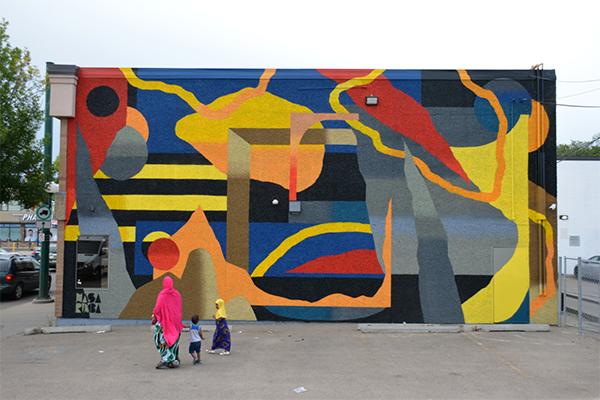
Photo by T. Peters/A. Toledo. Sand and Sky 2018 Mural by NASARIMBA (Mikhail Miller + Rachel Ziriada) as part of the Rust Magic International Mural Festival, in Edmonton, AB.
Maguire: What advice would you give to students about living and working as an artist?
Miller: I’m still figuring out the monetary side of my artistic practice. I’ve always had day jobs; then the pressure isn’t put on your art-making. It’s hard to decide how to make it work, there’s so many different messages. You can try to do the grant system, but it’s very challenging and a full-time job in itself. Kudos to people who are able to make that work. There’s also teaching. And then selling your work, which I have done here and there. It’s hard to place your artwork in a situation where it could become a commodity.
Maguire: It’s difficult to even talk about your art as a commodity.
Miller: Exactly. There’s a spectrum of ways to do things. I feel that art serves a social purpose and function, which doesn’t necessarily translate to selling your work. Sometimes the art world can be linked with a more capitalist way of thinking, which is something I don’t jive with, but also I’ve realized that maybe it’s something you need to get over and try out.
Things are shifting now, too. There’s not the path available anymore of getting a degree, getting a job and sticking with it for the rest of your life. My parents are great, but we still have those moments where they ask “what are you doing?” Ultimately, I have no idea what advice to give. Talk to people, build a community, maintain your playfulness, and maintain your practice. Pursuing art and music are hard things to do. It’s enjoyable and rewarding, but difficult to do and difficult to make it work.

Photo by Mike Tan. Certified Refurbished 2018 Mixed Media Installation by NASARIMBA (Mikhail Miller + Rachel Ziriada) as part of the WRECK CITY Residency and OFFICE CITY Exhibition, Calgary AB.
Maguire: Is there a specific moment where you realized you were serious about being an artist?
Miller: I got into art and photography when I was in high school. I was just waiting to go to ACAD, and it was such a relief when I got there. For myself, at some point early on it just made sense to me. I wasn’t really thinking about making money, but more in terms of what I want to do with my life. Early on I clued in that it was a life-long process that I would like to be engaged in. I have crisis moments and doubts, like anyone.
A lot has changed with social media. I honestly don’t really get excited about engaging with art that exists on a three inch screen. My perspective when I was 17, and just starting at ACAD, is likely totally different than someone starting at ACAD now. People are engaged in a way that is so different from when I was a student.
Maguire: I know what you mean about that feeling of relief. You realize you are looking in the right direction.
Miller: ACAD really shows you how to make decisions for yourself, and how to engage with your community. There’s a lot of pressures on people, and they get funneled into these safe careers. I even still feel those pressures sometimes.
For me, I got a little turned off by the “art world” processes. I think now that some of it had to do with being intimidated, and maybe afraid of failure. I was lucky, I found a community in Victoria that encouraged people to push each other. Finding a small and challenging community really helped me to keep making art and push my art further. Doing projects that were outside of the gallery, in public spaces, is something I’ve always liked doing. It’s hard to maintain your drive when you are writing all these proposals and not getting them.
It might sound a little vague, but use your creativity in different ways and stay excited. There’s lots of ways to be an artist – find what is right for you. Things can take time, a lot of time, and not necessarily happen right away.
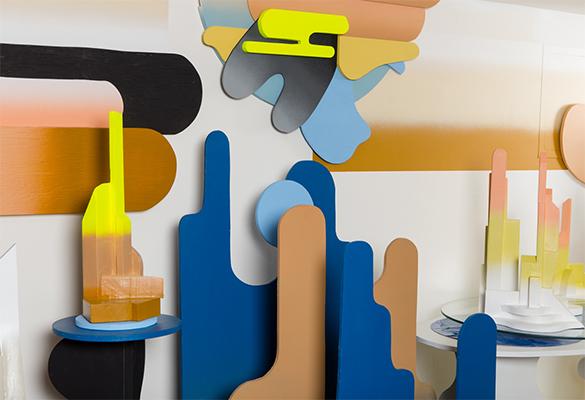
Photo by Stephen Harper. Reaching a Microverse 2018 Mixed Media Installation by NASARIMBA (Mikhail Miller + Rachel Ziriada) in a window gallery at the Arts Commons, Calgary AB.
